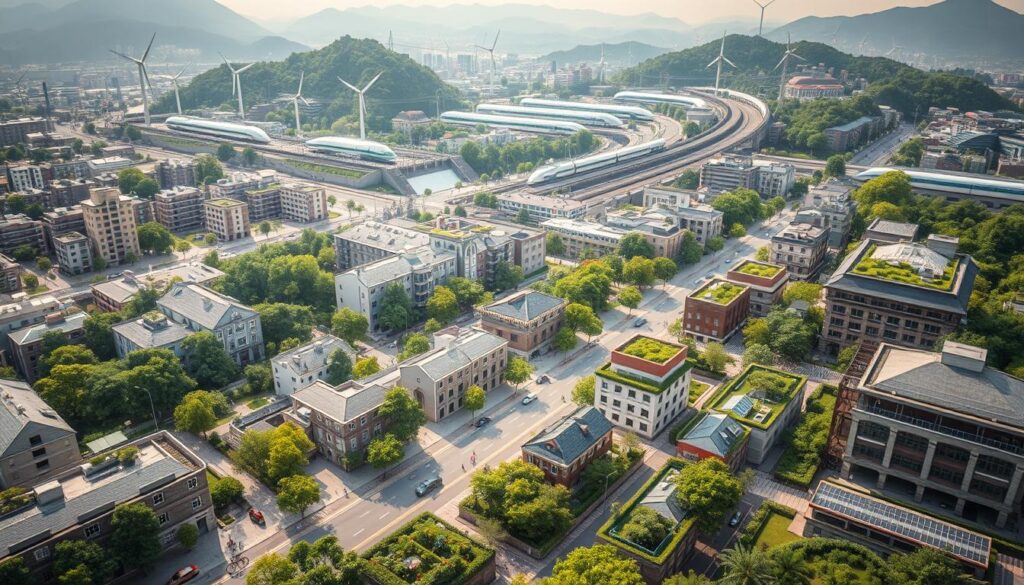Can we build a sustainable future without transforming the way we construct our cities and infrastructure? The answer lies in adopting innovative and eco-friendly practices that minimize environmental impact.
Designing buildings, roads, and other structures with sustainability in mind is crucial for reducing carbon emissions. By using sustainable building materials and practices, we can significantly decrease the environmental footprint of construction projects.
As we move towards a more sustainable future, it’s essential to rethink our approach to infrastructure development. This involves exploring new materials, technologies, and strategies that can help us achieve our environmental goals.
Key Takeaways
- Transforming infrastructure to be more sustainable is crucial for a sustainable future.
- Sustainable building materials and practices can significantly reduce environmental impact.
- Innovative technologies and strategies are key to achieving environmental goals.
- Adopting eco-friendly practices in construction can minimize carbon emissions.
- Rethinking infrastructure development is essential for a sustainable future.
Understanding Low-Carbon Infrastructure
As the world grapples with the challenges of climate change, low-carbon infrastructure has emerged as a vital component of sustainable development. The shift towards a more sustainable future necessitates a comprehensive understanding of what low-carbon infrastructure entails and its significance in reducing carbon emissions.
Definition and Importance
Low-carbon infrastructure refers to buildings and structures designed with the primary goal of reducing carbon emissions. This is achieved through the incorporation of energy-efficient technologies and the use of sustainable materials. According to experts, “Investing in low-carbon infrastructure is not just an environmental imperative but also an economic opportunity.” The importance of low-carbon infrastructure cannot be overstated, as it plays a crucial role in mitigating climate change by reducing greenhouse gas emissions.
For more insights on the latest trends in green infrastructure, visit World Civil Society.
Key Components of Low-Carbon Infrastructure
The key components of low-carbon infrastructure include energy-efficient buildings, sustainable materials, and renewable energy systems. Energy-efficient buildings are designed to minimize energy consumption through advanced insulation techniques, energy-efficient lighting, and smart building technologies. Sustainable materials, on the other hand, are sourced and used in ways that minimize environmental impact.
A notable example of low-carbon infrastructure in action is the integration of renewable energy systems, such as solar and wind power, into the built environment. This not only reduces reliance on fossil fuels but also decreases carbon emissions. As urban planning continues to evolve, incorporating sustainable urban planning practices will be essential in creating eco-friendly cities that thrive with minimal environmental impact.
By understanding and implementing low-carbon infrastructure, communities can significantly reduce their carbon footprint, contributing to a more sustainable future.
The Role of Renewable Energy in Infrastructure
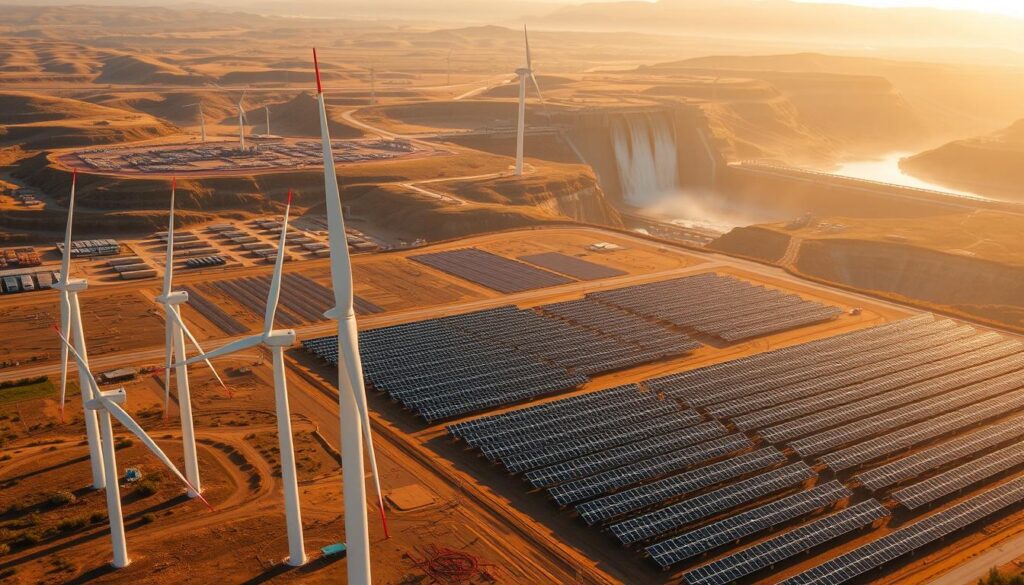
Renewable energy sources are transforming the way we build and manage infrastructure, paving the way for a low-carbon economy. The integration of renewable energy into infrastructure projects is crucial for reducing our dependence on fossil fuels and lowering carbon emissions. By leveraging solar, wind, and hydropower, we can create more sustainable and resilient infrastructure.
Solar Energy Solutions
Solar energy is becoming increasingly prominent in infrastructure development, offering a clean and abundant source of power. Solar panels can be integrated into buildings, roads, and other infrastructure elements, providing energy while minimizing environmental impact. The use of solar energy can significantly reduce the carbon footprint of infrastructure projects.
For more information on how renewable energy can raise ambition in infrastructure development, visit the United Nations’ page on renewable energy.
Wind Energy Integration
Wind energy is another vital component of renewable energy infrastructure. Wind turbines can be used to generate electricity, which can then be fed into the grid or used locally. The integration of wind energy into infrastructure requires careful planning to maximize efficiency and minimize environmental impacts.
Hydropower Potential
Hydropower is a significant source of renewable energy, particularly for regions with substantial water resources. Hydropower plants can provide a reliable and consistent source of electricity, contributing to the stability of the energy grid. The potential for hydropower development varies by location, but it remains a crucial element of renewable energy infrastructure globally.
Sustainable Urban Planning Practices
With urbanization on the rise, sustainable urban planning practices are essential for a sustainable future. As cities continue to grow, it’s crucial to adopt strategies that minimize environmental impact while enhancing the quality of life for urban residents.
Mixed-Use Development Benefits
Mixed-use developments are a cornerstone of sustainable urban planning, combining residential, commercial, and recreational spaces to reduce the need for lengthy commutes and promote walking and cycling. According to a study on sustainable urban planning, mixed-use developments can significantly decrease urban sprawl.
- Reduced traffic congestion
- Increased local economic activity
- Enhanced community interaction
By integrating different land uses, cities can become more livable and efficient. For instance, a mixed-use development might include apartments above retail stores, with public parks nearby. This not only supports local businesses but also fosters a sense of community.
| Benefits | Description | Impact |
|---|---|---|
| Reduced Commuting | Less need for personal vehicles | Lower emissions |
| Economic Boost | Vibrant local economies | Increased foot traffic |
| Community Building | Integrated public spaces | Enhanced social interaction |
Green Spaces in Urban Areas
Green spaces are vital components of sustainable urban planning, providing numerous benefits for both the environment and urban residents. As noted by experts, “Green infrastructure can be a cost-effective way to manage urban environmental challenges.” Incorporating green spaces into urban design can help mitigate the urban heat island effect, improve air quality, and offer recreational areas for residents.
“Urban green spaces are not just aesthetic additions; they are critical infrastructure for sustainable cities.”
For more insights on cutting construction costs and promoting sustainability, visit cutting construction costs in Africa.
Innovative Materials for Low-Carbon Projects
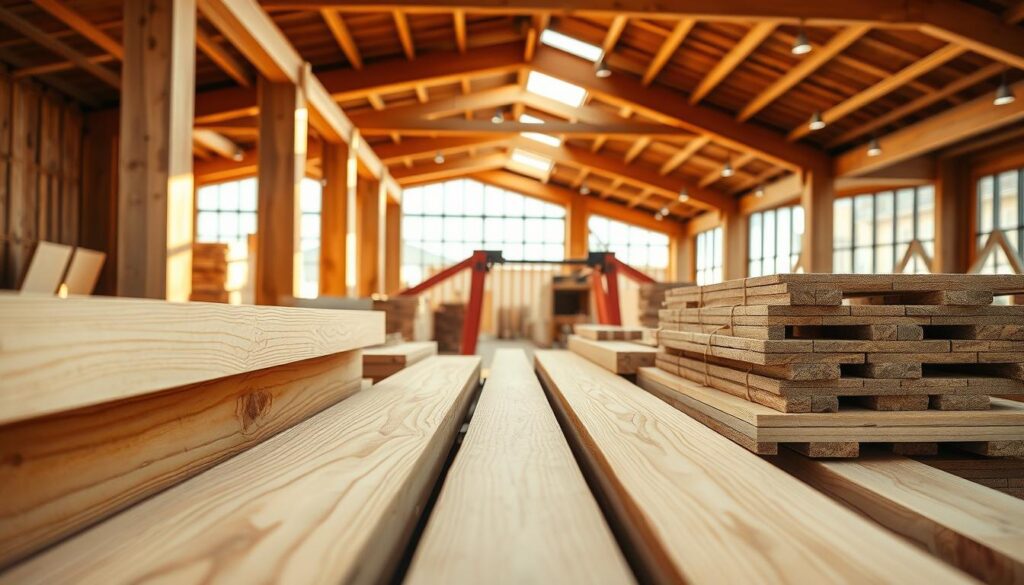
Innovative materials are playing a crucial role in reducing the carbon footprint of modern infrastructure projects. The use of such materials is a key component of eco-friendly development, enabling the construction industry to move towards more sustainable practices.
One of the primary ways to achieve low-carbon infrastructure is through the adoption of materials that are either recycled, upcycled, or sustainably sourced. This not only reduces waste but also decreases the demand for new, resource-intensive materials.
Recycled and Upcycled Materials
Recycled and upcycled materials are gaining popularity in construction due to their potential to significantly reduce environmental impact. For instance, low-carbon materials such as recycled steel can be used in place of virgin steel, reducing the energy required for production and the associated greenhouse gas emissions.
Some examples of recycled materials include:
- Recycled glass aggregates
- Reclaimed wood
- Recycled plastic lumber
Low-Carbon Concrete Alternatives
Traditional concrete is a significant contributor to carbon emissions due to the production of cement. Low-carbon concrete alternatives are being developed to mitigate this issue. These alternatives include:
| Material | Description | Carbon Reduction Potential |
|---|---|---|
| Supplementary Cementitious Materials (SCMs) | Materials like fly ash and slag that can replace a portion of cement | Up to 40% reduction |
| Bio-based Concrete | Concrete that incorporates organic materials | Significant reduction, varies by material |
As noted by experts, “The use of supplementary cementitious materials can significantly reduce the carbon footprint of concrete production.”
“The future of concrete is not just about replacing cement, but about rethinking the entire mix design to achieve sustainability.”
Sustainable Wood Products
Sustainable wood products are another crucial component of low-carbon infrastructure. Wood is a renewable resource that can be sustainably harvested, and when used in construction, it can store carbon for the lifetime of the building.
The benefits of using sustainable wood products include:
- Carbon sequestration
- Renewable resource
- Energy efficiency in production compared to traditional materials
In conclusion, the integration of innovative materials such as recycled and upcycled materials, low-carbon concrete alternatives, and sustainable wood products is crucial for the development of low-carbon infrastructure. These materials not only reduce the environmental impact of construction projects but also contribute to a more sustainable future.
Transportation Strategies for Low Carbon
Sustainable transportation solutions are essential for minimizing the environmental impact of urban development. As cities continue to grow, the need for effective and low-carbon transportation strategies becomes increasingly critical.
One of the key strategies for reducing carbon emissions in transportation is the adoption of electric public transit options. Electric buses and trains offer a cleaner alternative to traditional fossil fuel-based systems, significantly lowering emissions and improving air quality.
Electric Public Transit Options
Electric public transit is gaining traction worldwide due to its potential to reduce greenhouse gas emissions and operating costs. Cities that have implemented electric bus fleets have seen a significant decrease in emissions, contributing to a cleaner environment.
“The transition to electric public transit is a crucial step towards achieving sustainable urban mobility,” says a recent report by the International Transport Forum. This shift not only reduces emissions but also enhances the quality of life for urban residents.
Bicycle and Pedestrian Pathways
In addition to electric public transit, investing in bicycle and pedestrian pathways is another effective strategy for reducing vehicle dependency. By creating safe and accessible infrastructure for cyclists and pedestrians, cities can promote healthier and more sustainable transportation habits.
For instance, cities like Copenhagen and Amsterdam have successfully integrated extensive bicycle networks into their urban planning, resulting in a significant reduction in carbon emissions and improved public health.
Reducing Vehicle Dependency
Reducing vehicle dependency is crucial for lowering emissions and creating more livable cities. This can be achieved through a combination of strategies, including enhancing public transit, promoting non-motorized transport, and implementing policies that discourage the use of personal vehicles.
- Implementing congestion charges
- Enhancing public transit services
- Creating pedestrian-friendly zones
By adopting these strategies, cities can significantly reduce their carbon footprint and move towards a more sustainable future.
Energy Efficiency in Buildings

As the world moves towards a more sustainable future, energy efficiency in buildings plays a vital role. Buildings account for a significant portion of global energy consumption, making them a critical area for improvement in the quest for sustainability.
Smart Building Technologies
Smart building technologies are revolutionizing the way we manage energy in buildings. These technologies include advanced HVAC systems, energy management systems, and smart lighting solutions. By integrating these technologies, buildings can significantly reduce their energy consumption.
Key Features of Smart Building Technologies:
- Automated energy management systems
- Advanced HVAC controls
- Smart lighting solutions
- Integration with renewable energy sources
Retrofitting Existing Structures
Retrofitting existing buildings is a cost-effective way to improve energy efficiency. This involves upgrading building components such as insulation, windows, and HVAC systems to reduce energy consumption.
| Retrofitting Measure | Energy Savings | Cost |
|---|---|---|
| Upgrading Insulation | 15-20% | $5,000 – $10,000 |
| Replacing Windows | 10-15% | $8,000 – $15,000 |
| HVAC System Upgrade | 20-30% | $10,000 – $20,000 |
Passive Design Principles
Passive design principles focus on maximizing natural light and heat, reducing the need for mechanical systems. This includes strategies such as optimizing building orientation, using natural ventilation, and incorporating thermal mass.
Benefits of Passive Design:
- Reduced energy consumption
- Improved indoor air quality
- Enhanced occupant comfort
Circular Economy and Low Carbon
The integration of circular economy principles into infrastructure development is a key strategy for reducing carbon emissions. By adopting circular economy practices, we can significantly minimize the environmental impact of infrastructure projects, moving towards a more sustainable future.
A circular economy is an economic system aimed at eliminating waste and the continual use of resources. In the context of low-carbon infrastructure, this involves designing projects that are restorative and regenerative by design. This approach not only reduces waste but also promotes the use of renewable energy and sustainable materials.
Waste Reduction Techniques
Effective waste reduction is a critical component of circular economy practices in low-carbon infrastructure. Techniques such as recycling, reusing materials, and minimizing waste during the construction process are essential. For instance, recycling concrete and other materials can significantly reduce the amount of waste sent to landfills.
Moreover, adopting design for deconstruction principles allows for the easy disassembly and reuse of building components at the end of their life cycle. This approach not only reduces waste but also conserves the energy and resources required to produce new materials.
Product Life Cycle Considerations
Understanding the life cycle of products used in infrastructure projects is vital for making informed decisions that support low-carbon goals. This involves assessing the environmental impacts associated with all stages of a product’s life, from raw material extraction to end-of-life disposal or recycling.
By considering the life cycle of products, developers can identify opportunities to reduce environmental impacts. For example, selecting materials with lower embodied energy or those that can be easily recycled can significantly contribute to achieving low-carbon infrastructure goals.
Furthermore, adopting a circular economy approach encourages the use of product-as-a-service models, where manufacturers retain ownership of products and are incentivized to design more durable, recyclable, and sustainable products.
Financial Incentives for Low-Carbon Infrastructure
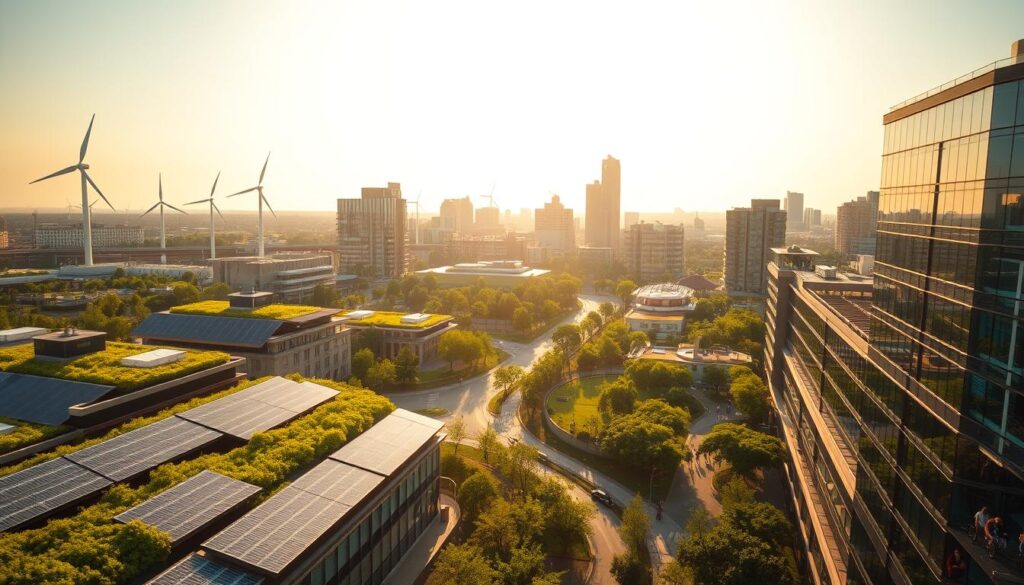
Financial incentives are pivotal in encouraging the adoption of low-carbon infrastructure, driving us towards a more sustainable environment. These incentives help mitigate the high upfront costs associated with eco-friendly development, making sustainable urban planning more accessible.
The role of financial incentives cannot be overstated. They are crucial for encouraging investments in low-carbon infrastructure. By providing a financial boost, governments can stimulate the growth of sustainable projects.
Government Grants and Funding
Government grants and funding are essential for supporting low-carbon infrastructure projects. These financial resources help cover the initial costs of sustainable development, making it more feasible for companies and cities to invest in eco-friendly technologies.
- Grants for renewable energy projects
- Funding for energy-efficient buildings
- Subsidies for sustainable transportation
For instance, government grants can be used to support research and development in new sustainable technologies, further driving innovation in the field.
Tax Incentives for Sustainable Practices
Tax incentives are another vital tool for promoting low-carbon infrastructure. By offering tax breaks or credits, governments can encourage businesses and individuals to invest in sustainable practices.
| Type of Tax Incentive | Description | Benefit |
|---|---|---|
| Tax Credits | Direct reduction in tax liability | Reduces the cost of investing in sustainable technologies |
| Tax Deductions | Reduces taxable income | Lowers the effective cost of sustainable investments |
| Property Tax Abatement | Reduces property taxes for sustainable buildings | Encourages the development of green buildings |
Case studies have shown that tax incentives can significantly increase the adoption of sustainable practices. For example, cities that offer property tax abatements for green buildings have seen a surge in eco-friendly construction projects.
In conclusion, financial incentives such as government grants and tax incentives are crucial for the development of low-carbon infrastructure. They not only make sustainable projects more financially viable but also encourage innovation and investment in eco-friendly technologies.
Community Engagement in Sustainable Development
Effective community engagement is pivotal for the success of sustainable development projects. It ensures that the needs and concerns of the local population are addressed, fostering a sense of ownership and cooperation.
Stakeholder Involvement
Stakeholder involvement is a critical component of community engagement. It includes identifying and collaborating with various groups, such as local residents, businesses, and community organizations. By doing so, sustainable development projects can gain valuable insights and support, ultimately leading to more successful outcomes. For more information on the importance of community engagement in climate action, visit Commonplace.
Education and Awareness Efforts
Education and awareness efforts are essential for informing the public about the benefits and challenges of sustainable development. This can be achieved through workshops, public meetings, and educational campaigns. By raising awareness, communities can make more informed decisions and actively participate in sustainable development initiatives.
Key strategies for effective education and awareness include:
- Utilizing multiple communication channels to reach a wider audience
- Providing clear, accessible information about sustainable practices
- Encouraging community participation through interactive events and activities
By engaging the community and promoting education and awareness, sustainable development projects can achieve greater success and long-term impact. This collaborative approach not only enhances the effectiveness of sustainable initiatives but also fosters a culture of sustainability within the community.
Policy Framework for Low-Carbon Initiatives
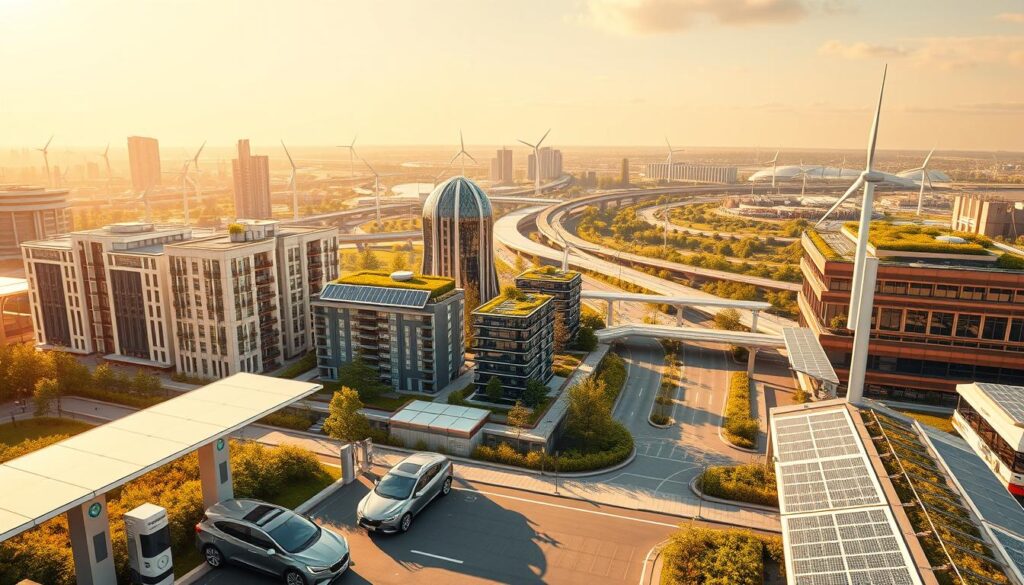
Low-carbon initiatives require a supportive policy framework to drive sustainable development. A comprehensive policy framework is essential for promoting low-carbon infrastructure and ensuring that climate-resilient infrastructure projects are implemented effectively.
Federal and State Regulations
Federal and state regulations play a crucial role in shaping the policy framework for low-carbon initiatives. At the federal level, regulations such as the Clean Air Act and the Clean Energy Standard provide guidelines for reducing greenhouse gas emissions and promoting clean energy.
State-level regulations also significantly impact low-carbon initiatives. For instance, states like California and New York have implemented their own climate goals and regulations, such as cap-and-trade programs, to drive low-carbon development.
Key Federal and State Regulations:
- Clean Air Act
- Clean Energy Standard
- State-level cap-and-trade programs
- Renewable Portfolio Standards (RPS)
International Agreements and Standards
International agreements and standards are vital for creating a global framework for low-carbon initiatives. The Paris Agreement, for example, sets a global goal to limit warming to well below 2°C and pursue efforts to limit it to 1.5°C above pre-industrial levels.
Other international standards, such as those developed by the International Organization for Standardization (ISO), provide guidelines for implementing low-carbon practices and managing climate-related risks.
| Agreement | Description | Impact |
|---|---|---|
| Paris Agreement | Global agreement to limit warming | Sets global climate goals |
| ISO Standards | Guidelines for low-carbon practices | Promotes best practices globally |
| United Nations SDGs | Sustainable Development Goals | Integrates low-carbon development into broader sustainability goals |
By understanding and leveraging these policy frameworks, stakeholders can better navigate the complexities of implementing low-carbon initiatives and contribute to a more sustainable future.
Technological Innovations Driving Change
Innovative technologies are playing a crucial role in shaping the future of sustainable infrastructure. As the world transitions towards a more sustainable and environmentally conscious future, technological advancements are at the forefront of this change.
Smart Grids and Energy Management
Smart grids represent a significant leap forward in energy management, enabling more efficient distribution and consumption of energy. By integrating advanced technologies such as IoT sensors and AI, smart grids can optimize energy supply and demand in real-time, reducing waste and improving overall efficiency.
According to a report, “Smart grids can reduce energy losses by up to 50% and improve the overall efficiency of the grid by integrating renewable energy sources more effectively.”
“The integration of renewable energy sources into the grid is crucial for reducing our reliance on fossil fuels and mitigating climate change.”
| Technology | Benefits | Impact |
|---|---|---|
| Smart Grids | Efficient Energy Distribution | Reduced Energy Losses |
| Building Information Modeling (BIM) | Enhanced Collaboration | Improved Project Outcomes |
Building Information Modeling (BIM)
Building Information Modeling (BIM) is transforming the construction industry by providing a digital representation of the physical and functional characteristics of a building. This technology enhances collaboration among stakeholders, improves project visualization, and enables more accurate planning and execution.
The use of BIM can lead to significant cost savings and reduced project timelines. As noted in a study on how AI is transforming civil engineering, BIM, when combined with AI, can further optimize construction processes.
Technological innovations like smart grids and BIM are crucial for driving the transition to low-carbon infrastructure. By leveraging these technologies, we can create more sustainable, efficient, and environmentally friendly infrastructure projects.
For more information on emerging technologies in low-carbon construction, visit ClimateWorks to explore innovative solutions.
Measuring and Reporting Carbon Footprint
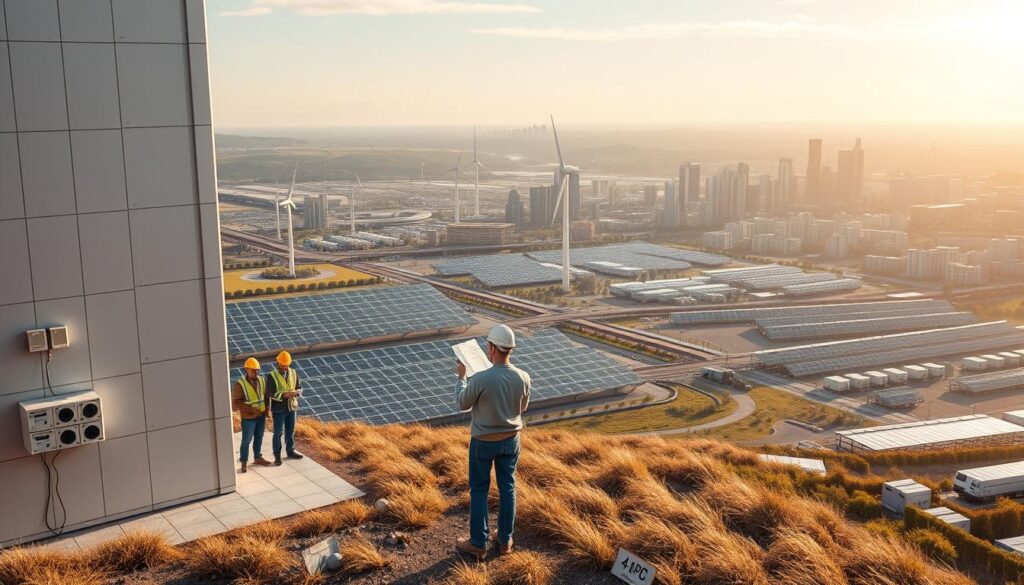
To achieve sustainable development, it is crucial to measure and report the carbon footprint of infrastructure projects accurately. Measuring and reporting carbon footprint is essential for assessing the effectiveness of low-carbon infrastructure initiatives.
The process involves several key steps, including carbon accounting practices and the use of tools for monitoring and evaluation. Accurate carbon footprint analysis helps in identifying areas of improvement and ensuring that projects meet their sustainability goals.
Carbon Accounting Practices
Carbon accounting practices are fundamental to measuring the carbon footprint of infrastructure projects. These practices involve quantifying the greenhouse gas emissions associated with the project lifecycle, from construction to operation.
Key components of carbon accounting include:
- Identifying emission sources
- Quantifying emissions
- Setting emission reduction targets
- Monitoring progress
Effective carbon accounting enables project developers to make informed decisions and stakeholders to assess the project’s environmental impact.
Tools for Monitoring and Evaluation
Various tools are available for monitoring and evaluating the carbon footprint of infrastructure projects. These tools range from software solutions to methodologies and frameworks that help in tracking emissions and assessing the effectiveness of mitigation measures.
Some of the commonly used tools include:
| Tool | Description | Application |
|---|---|---|
| Carbon footprint calculators | Software tools that calculate greenhouse gas emissions | Project planning and assessment |
| Life Cycle Assessment (LCA) | Methodology for assessing environmental impacts throughout a project’s lifecycle | Sustainability evaluation |
| Greenhouse Gas Protocol | Framework for quantifying and managing greenhouse gas emissions | Emission reporting and management |
These tools are essential for ensuring that low-carbon infrastructure projects are effectively monitored and evaluated, enabling continuous improvement in sustainability performance.
By leveraging these tools and practices, stakeholders can work together to achieve the goals of low-carbon infrastructure and sustainable development.
Case Studies in Low-Carbon Infrastructure
Case studies of eco-friendly development projects reveal effective strategies for reducing carbon footprints in urban areas. By examining successful low-carbon infrastructure projects, we can gain valuable insights into sustainable urban planning practices that can be replicated globally.
Successful US Projects
The United States has seen numerous innovative low-carbon infrastructure projects. For instance, the city of San Francisco has implemented a comprehensive zero-waste program, significantly reducing landfill waste. Additionally, cities like Denver have invested heavily in green building technologies, setting new standards for energy efficiency.
Another notable example is the Chicago Riverwalk, which has transformed an industrial waterfront into a vibrant public space while incorporating sustainable design principles. These projects demonstrate the potential for low-carbon infrastructure to enhance urban livability while reducing environmental impact.
Lessons Learned from Global Examples
Globally, cities are adopting innovative approaches to low-carbon infrastructure. For example, Copenhagen aims to be carbon neutral by 2025, with a comprehensive plan that includes district heating and cooling, and a focus on cycling infrastructure. Case studies like these provide valuable lessons on the importance of integrated planning and community engagement.
Furthermore, cities like Singapore have implemented smart grid systems to optimize energy distribution and consumption. These international examples highlight the importance of adopting a holistic approach to low-carbon infrastructure, incorporating both technological innovation and policy reform.
By studying these case studies, cities worldwide can learn from both the successes and challenges faced by other urban areas, accelerating the transition to a more sustainable, low-carbon future.
Challenges and Barriers to Implementation

Despite its benefits, low-carbon infrastructure implementation is hindered by various obstacles. The transition to sustainable infrastructure requires significant investment and technological advancements, which can be challenging to achieve.
Economic Constraints
One of the primary challenges is the high upfront cost associated with low-carbon infrastructure projects. The initial investment required for renewable energy systems, green buildings, and sustainable transportation can be substantial, making it difficult for some regions to adopt these technologies.
Economic constraints also include the lack of financial incentives and funding mechanisms for low-carbon projects. Governments and private investors are often hesitant to invest in new technologies due to the perceived risks and uncertainties associated with their returns on investment.
Technical Limitations
Technical limitations pose another significant barrier to the implementation of low-carbon infrastructure. The integration of renewable energy sources into the grid can be complex, requiring advanced technologies and infrastructure to manage energy distribution and storage effectively.
Moreover, the development and deployment of new low-carbon technologies can be hindered by the lack of standardization and interoperability. This can lead to compatibility issues and increased costs, further complicating the transition to sustainable infrastructure.
Addressing these challenges will require a concerted effort from governments, industries, and communities to develop and implement effective solutions. By understanding the economic and technical constraints, we can begin to formulate strategies to overcome them and achieve a more sustainable future.
The Future of Low-Carbon Infrastructure
The future of low-carbon infrastructure is poised to transform the way we build and interact with our environment, driving us toward a more sustainable future. Emerging trends and practices are set to play a crucial role in this transformation.
Advancements in Carbon-Neutral Technology
Advances in carbon-neutral technology are expected to drive significant reductions in greenhouse gas emissions. Innovations such as smart grids and energy-efficient buildings will be pivotal in achieving a sustainable future.
Vision for Sustainable Cities
Sustainable cities of the future will be characterized by green spaces, efficient public transportation, and buildings that utilize renewable energy sources. By embracing low-carbon infrastructure, we can create cities that are not only environmentally friendly but also economically viable and socially equitable.
As we move forward, the integration of sustainable practices and carbon-neutral technology will be essential in shaping a world that is better equipped to handle the challenges of climate change.
